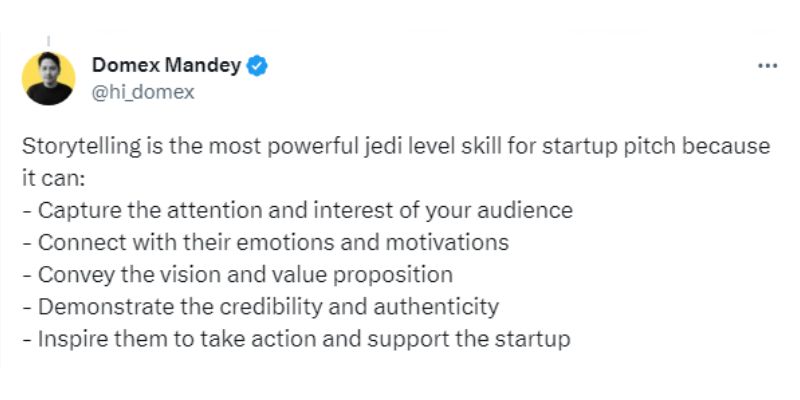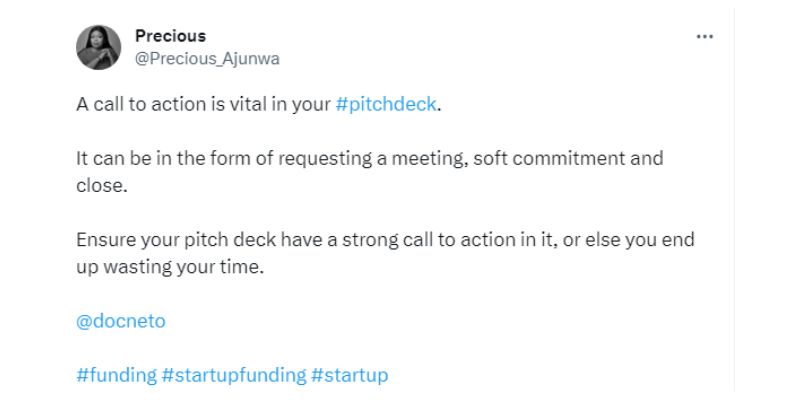How to Craft a Perfect Pitch Deck: 10 Expert Tips
A pitch deck is more than just a presentation; it’s the key to acquiring funding opportunities and the ultimate success of the startup. When starting a business, securing capital is crucial, and to do that, you need to persuade potential investors.
But how? It’s not just about building relationships or having great communication skills. It’s about presenting your investment opportunity in a way that gets them excited about partnering with you.
The secret? A captivating pitch deck. With the right ingredients, your pitch deck can transform your startup’s vision into a story that not only informs but also entices.
Before discussing the essential components and must-have ingredients of a pitch deck, let’s first understand the basic fundamentals of a startup pitch deck: What it is and why startups need one. What’s the primary purpose of crafting such a deck?
What is a Pitch Deck and Why is it Important for Startups?
A pitch deck is a series of slides crafted to describe a startup’s vision, aiming to persuade investors to buy into its future.
Originating from old-school presentations where “slides” on overhead projectors depicted ideas, today’s pitch decks are digital, using platforms like PowerPoint, Google Slides, or Figma if you want a sexy design! They combine compelling narratives with visuals to convey information about a company or product.
Whether sent to potential investors or used during in-person or virtual pitches, a pitch deck is invaluable. It not only showcases a startup’s promise but also serves as its first impression to investors.
In the competitive startup fundraising world, a compelling pitch deck can be the difference between securing investment or not.
So, what should be the essential elements of a standout pitch deck? Let’s explore the 10 must-have ingredients every successful pitch deck should possess.
10 Must-Have Pitch Deck Ingredients
Creating a standout pitch deck for your startup? Here are 10 essential ingredients to ensure it captivates your potential investors and sets your startup on the path to success:
1. Dynamic Storytelling: Your Startup’s Story
Telling a compelling story is essential for a pitch deck. It means sharing your startup’s journey in a way that’s clear and relatable. Instead of diving deep into every detail, your aim is to pique interest.
Talk about the hurdles you’ve crossed and how your product or service makes a difference in customers’ lives. Good stories resonate with people. They can stir emotions and sway them toward your vision.
Starting your pitch with a story about your startup’s roots or a testimonial about how your product positively impacted a user can be powerful.
Moreover, a unique company story makes your startup memorable. Highlighting what’s distinct about your team not only garners attention but also fosters trust. It becomes a testament to why potential investors or partners should join your journey.
2. A Perfect Structure
A pitch deck’s structure can make or break your presentation. An effective sequence can create a compelling narrative for your business idea. While it’s tempting to provide exhaustive details, excessive slides can overwhelm and disengage listeners.
Conversely, too few might undersell your vision. Striking a balance with 10-15 slides, each honing in on a single crucial point is key.
Notably, the design and visual appeal of the deck can enhance comprehension, making it as important as the content. In essence, structure and design combined determine the success of your pitch.
Must-Have Slides for a Pitch Deck:
Here are the most important slides that a perfect deck structure must have:
- Introduction Slide: Your business snapshot. Engage with a concise overview and value proposition.
- Problem Slide: Highlight a specific market problem. Make it relatable and urgent.
- Why Now: Explain why the problem is critical now. Use timely statistics or trends. Show the urgency of the problem and then your solution.
- Solution: Detail your unique solution. Link it clearly to the problem.
- Product: Showcase the key features and benefits of your product.
- Market: Define your market’s size and your potential share. Use both top-down and bottom-up approaches.
- Competition: Identify the main competitors and your unique edge.
- Go-to-Market Strategy: Outline your GTM plan to capture the market. Include target audience and distribution methods.
- Traction: Demonstrate business progress with metrics like revenue, KPIs, or media coverage.
- Team: Highlight key team members’ roles and their expertise, demonstrating why your team is best.
- Fundraising: Detail funds raised and future needs. Project growth over the next few years.
3. Design and Visual Consistency
A pitch deck is your business’s visual ambassador. Consistent, engaging design not only captivates the audience but also reinforces your brand’s identity.
An inconsistent deck can confuse or even alienate potential investors. Conversely, a well-designed, visually harmonious presentation can communicate professionalism, dedication, and a keen eye for detail—qualities investors value.
Best Design and Visual Tips for Pitch Decks:
- Uniform Color Palette: Stick to a select set of colors that reflect your brand, ensuring easy recognition and a cohesive look.
- High-Quality Images: Use relevant, professional photos that amplify your message without overwhelming the slide’s content. Don’t just use images to fill empty spaces; they must help the investor understand
- Minimize Text: Less is more. Highlight key points, and avoid clutter. Let your words during the pitch fill in the details.
- Maintain Font Consistency: Choose legible fonts and keep their size and style consistent throughout to ensure readability and professionalism.
- Single Message Per Slide: Each slide should convey one central idea, making it easier for the audience to follow and absorb the content.
4. Speak With Numbers
A successful pitch deck speaks more with numbers than words. Numbers show evidence of your startup’s progress and potential.
Always use the latest stats and market research to earn investor trust. Traction, or your company’s growth, is proof you’re on the right track.
Before each pitch, update your deck with new achievements or metrics. Cluttered slides confuse investors, so keep it neat. Aim for 6-8 lines or around 30 words on each slide.
Avoid using too much text. Instead, let clear, strong numbers make your point. Keep it straightforward: use numbers to tell your story and grab the attention of your audience.
5. An Attractive Market Opportunity
Another important ingredient for a successful pitch deck and to win investors, a pitch deck must highlight a tempting market opportunity and a perfect marketing strategy. Investors seek profits, so founders must show there’s demand for their offer and that they have tapped that demand.
Researching the market thoroughly is key. Your deck should then paint this opportunity vividly, hinting at big profits. Though a market size slide typically handles this, your entire deck should echo this potential, including through traction.
Highlight the target market size, its growth, and who exactly you’re aiming for. What’s the scope of the problem you’re tackling? Remember, it’s not just about market numbers but making investors see and feel the vast potential ahead.
6. A Realistic Business Plan and Financial Projections
Your pitch deck must show a clear, believable business plan and financial outlook. Use easy charts for clear data presentation. Highlight how you’ll earn, detailing pricing, marketing plan, customer data, and growth projections.
Stay grounded – investors often halve sky-high predictions. Ground your growth in real data or relatable industry examples. For early-stage startups, lean on convincing projections and competitor models to show potential growth.
Always remember, to impress, you need more than just big market numbers; showcase why the market’s ripe for your solution. Research thoroughly to understand both market size and your ideal customer traits.
7. Clear Call to Action (CTA)
End your pitch deck with a clear call to action (CTA). A strong CTA adds urgency and can secure the investment you’re seeking. It’s not just about presenting facts but guiding investors on what to do next.
Whether you’re seeking funding, partners, or deeper talks, make your Ask evident. But be smart. Match your funding request to the investor’s capacity. If you’re pitching to a big fund, don’t undersell with a small ask.
It’s vital that investors see the path forward and feel a push to act. Make their next steps simple and obvious.
8. Empathy and Audience Understanding
For a pitch deck to truly resonate, it needs empathy. This means understanding and connecting emotionally with investors. Why? Because genuine empathy builds trust.
When startups weave in relatable narratives, they not only convey their business ideas but also evoke feelings. This emotional bond can be a game-changer. It’s more than just facts and figures; it’s about sharing a story that investors can feel and relate to.
Keep it simple, direct, and heartfelt. After all, pitch decks are more than tools; they’re a window into your passion and vision. Make sure investors see, feel, and understand that.
9. Impactful Headlines
Last but not least, startups’ pitch deck isn’t just about sleek designs or fancy graphics; it’s anchored in the headlines. These headlines aren’t mere placeholders. They narrate the essence of your startup, telling a captivating story in brief, meaningful chunks.
But here’s the challenge: while narratives are easy to grasp, how do you simplify without diluting the essence? The magic lies in specificity.
Ditch generic titles. Instead of just ‘Team’, go with ’15y track record both building in selling in XZY industry’. Such headlines paint a vivid picture, emphasizing the unique value and story of your startup.
Remember, your headline should be self-sufficient. Read it, and you instantly get the slide’s core message. That’s the power of a headline done right.
Mistakes to Avoid for Early Founders
“Even the best ideas can be undermined by a poor pitch,” notes business expert Jane Smith. Early founders, while enthusiastic, often trip on pitfalls during presentations. So, what are the must-known red flags for founders when crafting a startup pitch deck?
10 Red Flags in a Startup Pitch Deck:
- Overloaded Slides: Avoid cramming too much into slides; it confuses and overwhelms investors.
- Dissing Competitors: Be cautious, and always show respect; you never know who’s listening.
- Jargon Overload: Avoid technical lingo. Aim for simplicity and clarity.
- Poor Graphics: Low-quality visuals detract. Invest in good graphics to enhance your message.
- Excessive Financials: Give a snapshot. Detailed finances can come later.
- Missing Storytelling: Narratives connect. Weave a compelling story for memorability.
- No Market Validation: Showcase real numbers and market traction. Avoid ambiguity.
- Vague Financial Projections: Be clear and realistic with your financial roadmap.
- Unclear Differentiation: Highlight what sets you apart from peers clearly and confidently.
Remember, capturing investor attention requires clarity, authenticity, and passion. Avoid these pitfalls to make a lasting impact.
Conclusion
Crafting the perfect pitch deck is both an art and a science. It’s not just about presenting facts; it’s about telling a story and resonating with your audience. Every slide, every word, should be intentional and serve a purpose.
Avoid common pitfalls, stay authentic, and always aim for clarity. Remember, at the heart of every successful pitch is a genuine connection with your audience.
So, focus on that connection, be transparent, and let your passion shine through. With the right approach, your pitch deck can open doors and set you on the path to success.












